Expirations
All in-force policies and expired policies not yet sent to history can be found and tracked from HOME > EXPIRATIONS link. The expirations tab is used to generate renewal lists (by using the search filter) for the agency. Once a policy is no longer in force and is sent to history, it is removed from the expirations tab.
When the policy has been renewed, Nexsure removes the policy from the expirations tab automatically. For
information on renewing expired policies, see Servicing
> Renewals.
Note: Although a maximum of 2000 records can be returned in a search, up to 5000 records can be exported.

Policies that are restricted are displayed only if the person logged on is assigned to them. All other non-restricted policies are displayed and can be searched for by all staff members (in accordance with their security). There are several options when working with policies on the expirations tab. Notice the options at the top of the expirations tab and the active icons within the tab.

The following options are available when working on the expirations tab:
- Branch: The Branch
 list box in the upper left can be used to select a branch, this will narrow the search results. Once a branch is selected, expirations tied to the selected branch are displayed.
list box in the upper left can be used to select a branch, this will narrow the search results. Once a branch is selected, expirations tied to the selected branch are displayed.
- Showing Page: The Arrow

 icons can be used to navigate through pages of search results.
icons can be used to navigate through pages of search results.
- First Page
 icon.
icon.
- Previous Page
 icon.
icon.
- Next Page
 icon.
icon.
- Last Page
 icon.
icon.
- Page List: Click the Page List
 arrow to open a list of all search results pages. Select the desired page number to open that page of search results.
arrow to open a list of all search results pages. Select the desired page number to open that page of search results.
-
 Export:
Click [Export] to generate a
Microsoft® Excel® spreadsheet from the expirations displayed on the screen.
Exporting to Excel can help to manage large amounts
of records that can be returned by using Excel's search,
sort, and print capabilities. A maximum of 5000 records can be exported.
Export:
Click [Export] to generate a
Microsoft® Excel® spreadsheet from the expirations displayed on the screen.
Exporting to Excel can help to manage large amounts
of records that can be returned by using Excel's search,
sort, and print capabilities. A maximum of 5000 records can be exported.
Note: If exported policy numbers are longer than 12 characters, those number may need to be  reformatted after exporting them to Excel. By default, Excel uses the scientific notation format for numbers longer than 12 characters. For example, when 1231231231234 is entered in a cell, Excel displays 1.23123E+12. No matter how large the cell width, Excel still displays a number larger then 12 characters in scientific notation.
reformatted after exporting them to Excel. By default, Excel uses the scientific notation format for numbers longer than 12 characters. For example, when 1231231231234 is entered in a cell, Excel displays 1.23123E+12. No matter how large the cell width, Excel still displays a number larger then 12 characters in scientific notation.
To reformat numbering in the cells, do the following:
- Select the cells that will hold the larger values and right-click the selection.
- Select Format Cells.
- In the Number tab, select the desired format (e.g., Number).
- Click OK.
Now when values are entered that have more than 12 characters they will be shown in the format selected.
- Search Filters: Click [Show] or [Hide] to toggle the Search Filters screen.

The options available on the Search Filters screen are:
- Save Filter Settings: Selecting the Save Filter Settings check box on the Search Filters screen and clicking Search will change the default Search Filter setting. The next time the expirations tab is opened, the policies returned will be filtered by the saved setting. Exercise caution when using the Save Filter Settings check box with a date range as returned policies will be restricted to that date range. As a general rule, check the filter settings each time this tab is accessed.
- Client Name: Enter the name of a client to return results that include all policies with expirations for a particular client. Enter at least one character to narrow the search results. Entering some of the Client Name returns a broader result, enter most of the name for more specific results.
- Client Type: There are two client types in Nexsure: Commercial and Personal. The search can be narrowed to make the results returned specific to a commercial or personal client.
- Policy Status: Select a Policy Status. The available selections are:
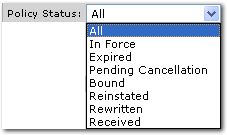
For more information about each status type see Marketing and Policy Status Types
- Policy Mode: Select a Mode from list. The available selections are:
- All
- New
- New on Existing
- Renew
- Re-New-Co
For more information about each mode type see Policy Code Definitions
- Bill Method: Select the Bill Method that is used for the policy. The available selections are:
- All
- Agency Bill
- Direct Bill
- Eff. Date (Fr): Click the Calendar
 icon to select the beginning date in a date range. A date range can be selected to return policies with term effective dates in the date range. Click the Variable
icon to select the beginning date in a date range. A date range can be selected to return policies with term effective dates in the date range. Click the Variable  icon and enter a variable number of days to set a continuous date range to be used with Save Filter Settings. Enter + or - and the number of days up to three digits. The date will then be + (after) or - (before) the current date. Policy term effective dates can be created three ways:
icon and enter a variable number of days to set a continuous date range to be used with Save Filter Settings. Enter + or - and the number of days up to three digits. The date will then be + (after) or - (before) the current date. Policy term effective dates can be created three ways:
- If an opportunity was created and sent to marketing, the policy term effective date will default to the X/BOR Date of the opportunity.
- If a marketing submission was created clicking SERVICING on the Client menu, the policy term effective date will default to the Eff. Date entered on the servicing tab.
- If a marketing submission was created by clicking MARKETING on the Client menu, the policy effective date will default to the current date.
- Exp. Date (Fr): Click the Calendar
 icon to select the beginning date in a date range. A date range can be selected to return all policies with term expiration dates in the date range. Click the Variable
icon to select the beginning date in a date range. A date range can be selected to return all policies with term expiration dates in the date range. Click the Variable  icon and enter a variable number of days to set a continuous date range to be used with Save Filter Settings. Enter + or - and the number of days up to three digits. The date will then be + (after) or - (before) the current date.
icon and enter a variable number of days to set a continuous date range to be used with Save Filter Settings. Enter + or - and the number of days up to three digits. The date will then be + (after) or - (before) the current date.
- Issuing Carrier: An Issuing Carrier is the company that issues the policy. Enter at least one character to narrow the search results. Entering some of the Issuing Carrier name returns a broader result, enter most of the Issuing Carrier name for more specific results.
- Updated Date (Fr): Click the Calendar
 icon to select the beginning date in a date range. A date range can be selected to return all policies with Updated Dates in the date range. Click the Variable
icon to select the beginning date in a date range. A date range can be selected to return all policies with Updated Dates in the date range. Click the Variable  icon and enter a variable number of days to set a continuous date range to be used with Save Filter Settings. Enter + or - and the number of days up to three digits. The date will then be + (after) or - (before) the current date.
icon and enter a variable number of days to set a continuous date range to be used with Save Filter Settings. Enter + or - and the number of days up to three digits. The date will then be + (after) or - (before) the current date.
- Business Type: Click the Ellipsis
 button to select a business type for which to search.
button to select a business type for which to search.
- Eff. Date (To): Click the Calendar
 icon to select the ending date in a date range. A date range can be selected to return all policies with term effective dates in the date range. Click the Variable
icon to select the ending date in a date range. A date range can be selected to return all policies with term effective dates in the date range. Click the Variable  icon and enter a variable number of days to set a continuous date range to be used with Save Filter Settings. Enter + or - and the number of days up to three digits. The date will then be + (after) or - (before) the current date.
icon and enter a variable number of days to set a continuous date range to be used with Save Filter Settings. Enter + or - and the number of days up to three digits. The date will then be + (after) or - (before) the current date.
- Exp. Date (To): Click the Calendar
 icon to select the ending date in a date range. A date range can be selected to return all policies with term expiration dates in the date range.
icon to select the ending date in a date range. A date range can be selected to return all policies with term expiration dates in the date range.
- Billing Carrier: The Billing Carrier is the company who the agency owes money to or who will pay the agency
for direct bill policies. Enter at least one character to narrow the search results. Entering some of the Billing Carrier name returns a broader result, enter most of the Billing Carrier name for more specific results.
- Updated Date (To): Click the Calendar
 icon to select the ending date in a date range. A date range can be selected to return all policies with Updated Dates in the date range. Click the Variable
icon to select the ending date in a date range. A date range can be selected to return all policies with Updated Dates in the date range. Click the Variable  icon and enter a variable number of days to set a continuous date range to be used with Save Filter Settings. Enter + or - and the number of days up to three digits. The date will then be + (after) or - (before) the current date.
icon and enter a variable number of days to set a continuous date range to be used with Save Filter Settings. Enter + or - and the number of days up to three digits. The date will then be + (after) or - (before) the current date.
- Policy No: Enter at least one digit of the policy number. The more digits of the policy number entered the narrower the search results.
- Assignment: Enter the name of the person to whom the policy has been assigned. Enter at least one character to narrow the search results. Entering some of the Assignment name returns a broader result, enter most or full first and last names for more specific results.
- Responsibility: Enter the name of the person with primary responsibility for the policy. Enter at least one character to narrow the search results. Entering some of the Responsibility name returns a broader result, enter most or full first and last names for more specific results.
- Updated By: Enter the name of the person that last updated the policy. Enter at least one character to narrow the search results. Entering some of the Updated By name returns a broader result, enter most or full first and last names for more specific results.
- Retail Agent: Enter the name of a Retail Agent associated with the policy.
- LOB: Enter the line of business for the policy. Enter at least one character to narrow the search results. Entering some of the line of business title returns broader results, enter most of the line of business for more specific results.
- Pending Non-renewals Only: Selecting the check box beside Pending Non-renewals Only and searching will return all policies that are not in history but flagged as a non-renewal.
- Sort Filters: Use the Sort Filters to sort the results of the expirations search.

The options available on the Sort Filters screen are:
- Sort Field 1: Select a column heading from the Sort Field 1 list. The search results will be sorted by the column selected in the Sort Field 1 list. The available selections are:
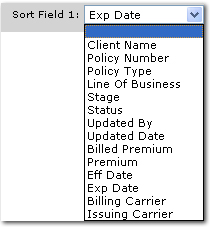
- Sort Order 1: Select either Ascending or Descending to set the order of the policies returned. Ascending will set the order from A-Z. Descending will set the order from Z-A. The Sort Field 1 will be the first sort and Sort Field 2 will be the sub sort.
- Sort Field 2: Select a column heading from the Sort Field 2 list. The search results will be sorted by the column selected in the Sort Field 2 list. The available selections are:

- Sort Order 2: Select either Ascending or Descending to set the order of the policies returned. Ascending will set the order from A-Z. Descending will set the order from Z-A. The Sort Field 1 will be the first sort and Sort Field 2 will be the sub sort.
- Clear: Click Clear to remove all entries in the Search Filter and Sort Filters fields.
Important: Clicking Clear does not remove the Save Filter Settings selection.
- Search: Click Search. The results of the Search Filter criteria and Sort Filter settings are displayed. A maximum of 2000 records can be returned in the search results.
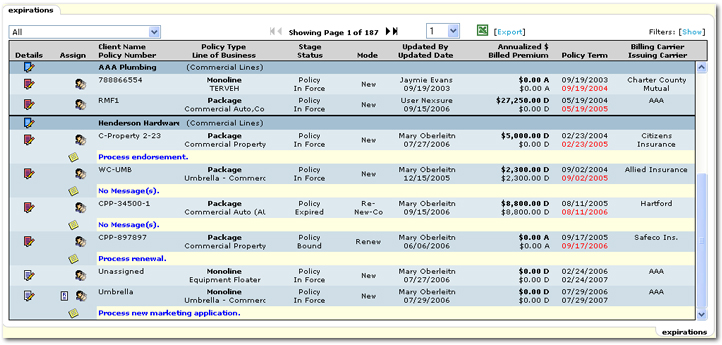
The following columns are displayed in the expirations search results:
- Details: There are three types of Details icons that will each give access to different information:
- The blue Client Details
 icon beside the entity name will display the client profile tab. Right-clicking the Client Details
icon beside the entity name will display the client profile tab. Right-clicking the Client Details  icon will display the following navigation options:
icon will display the following navigation options:
- Open: Opens the client card file tab.
Opens the Add New Opportunity dialog box to choose a line of business.
- Add New Opportunity: Opens the Add New Opportunity dialog box to choose one or more line of business.
- Market New Line of Business: Adds a marketing record with the expiration date of the existing policy as the effective date of the marketing submission and brings up the Add Line of Business screen.
- The red Details
 icon beside the entity name will display the change status dialog box. Click OK to change the status of the policy to Expired.
icon beside the entity name will display the change status dialog box. Click OK to change the status of the policy to Expired.
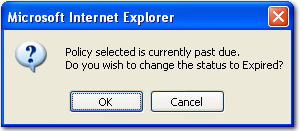
Right-clicking the red Details  icon will display the following navigation options:
icon will display the following navigation options:
- Open: Opens the underwriting tab.
- Market Existing: Copies the forms and adds to marketing with the expiration date of the submission as the effective date to create a new marketing submission.
- Print: Click this link to print the forms associated with the policy.
- Renew: Selects this version of the policy to renew. There is no opportunity to select policies from marketing, split or combine policies.
- Send to History: Opens the underwriting tab and the Reasons window to select identifying why the policy is being sent to history.
- Service: Opens the servicing tab allowing a service option to be selected while maintaining this policy as the policy being serviced.
- The Policy Details
 icon will display the underwriting tab for that policy. Right-clicking the Policy Details
icon will display the underwriting tab for that policy. Right-clicking the Policy Details  icon will display the following navigation
options:
icon will display the following navigation
options:
- Open: Opens the underwriting tab.
- Market Existing: Copies the forms and adds to marketing with the expiration date of the submission as the effective date to create a new marketing submission.
- Print: Click this link to print the forms associated with the policy.
- Renew: Selects this version of the policy to renew. There is no opportunity to select policies from marketing, split or combine policies.
- Send to History: Opens the underwriting tab and the Reasons window to select identifying why the policy is being sent to history.
- Service: Opens the servicing tab allowing a service option to be selected while maintaining this policy as the policy being serviced.
- Assign: Click the Assign
 icon to display the Assignment List dialog box with the list of people in the agency assigned to this policy. The Assignment List is populated
from the assignment tab.
icon to display the Assignment List dialog box with the list of people in the agency assigned to this policy. The Assignment List is populated
from the assignment tab.
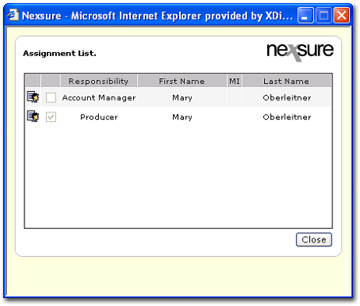
- Retail Agent: If a Retail Agent is associated with the client, the Retail Agent
 icon will be displayed. Click the Retail Agent
icon will be displayed. Click the Retail Agent  icon to open the Retail Agent > card file tab.
icon to open the Retail Agent > card file tab.
- Action Items: Click the Action Items
 icon to display the Action Items dialog box. The action can then be modified or updated.
icon to display the Action Items dialog box. The action can then be modified or updated.

- Client Name: The client's name will be
displayed as the primary named insured. The client's name displays once regardless of the number of expiring policies.
- Policy Number: The Policy Number will be displayed.
- Policy Type: Nexsure
identifies policy types on the underwriting tab. The Policy Type will display as either Monoline or Package. Holding the cursor over the Policy Type will display the information in a larger font for ease of reading. Clicking the item in the summary view will open a display box containing the selected information.
- Line of Business: The Line of Business the policy was created for. The line
of business is identified on the underwriting tab. Holding the cursor over the Line of Business will display the information in a larger font for ease of reading. Clicking the item in the summary view will open a display box containing the selected information.
- Stage: The policy Stage will display as Policy. The Stage is assigned by Nexsure.
- Status: The Nexsure assigned Status of the policy from the underwriting tab is displayed. All possible policy status types are:
- In Force
- Received
- Future
- Expired
- Bound
- Reinstated
- Rewritten
- Submitted
- Pending-Cancellation
For more information about each status type see Marketing and Policy Status Types
- Mode: The policy Mode is displayed. All possible mode types are:
- New
- Renew
- Re-New-Co
For more information about each mode type see Policy Code Definitions
- Updated By: Enter the name of the person that last updated the policy. Enter at least one character to narrow the search results. Entering some of the Updated By name returns a broader result, enter most or full first and last names for more specific results.
- Updated Date: Date
the policy was last updated.
- Annualized $ / Billed Premium: The Annualized $ and Billed Premium are determined by Nexsure and display the annualized and billed amounts through posted invoices. The
bill type (agency or direct) will be displayed to the right of the premium
as an A or D
respectively.
- Policy Term: Populated
from the effective and expiration date fields on the underwriting
tab. The expiration
dates are color-coded to show the proximity to the expiration date:
- Red: Expired.
- Orange: Expires in 30 days or less.
- Green: Expires in 90 days or less (at 30 days color changes to orange).
- Black: Policy is greater than 90 days from expiration.
- Billing Carrier: The Billing Carrier is the company who the agency owes money to or who will pay the agency
for direct bill policies. The Billing Carrier is identified on the underwriting tab in the policy header.
- Issuing Carrier: An Issuing Carrier is the company that issues the policy. The Issuing Carrier is identified on the underwriting tab in the policy header.



 arrow to open a list of all search results pages. Select the desired page number to open that page of search results.
arrow to open a list of all search results pages. Select the desired page number to open that page of search results.  reformatted after exporting them to Excel. By default, Excel uses the scientific notation format for numbers longer than 12 characters. For example, when 1231231231234 is entered in a cell, Excel displays 1.23123E+12. No matter how large the cell width, Excel still displays a number larger then 12 characters in scientific notation.
reformatted after exporting them to Excel. By default, Excel uses the scientific notation format for numbers longer than 12 characters. For example, when 1231231231234 is entered in a cell, Excel displays 1.23123E+12. No matter how large the cell width, Excel still displays a number larger then 12 characters in scientific notation.


 button to select a business type for which to search.
button to select a business type for which to search.



 icon beside the entity name will display the client profile tab. Right-clicking the Client Details
icon beside the entity name will display the client profile tab. Right-clicking the Client Details  icon will display the following navigation options:
icon will display the following navigation options: icon beside the entity name will display the change status dialog box. Click OK to change the status of the policy to Expired.
icon beside the entity name will display the change status dialog box. Click OK to change the status of the policy to Expired. 
 icon will display the following navigation options:
icon will display the following navigation options:  icon will display the underwriting tab for that policy. Right-clicking the Policy Details
icon will display the underwriting tab for that policy. Right-clicking the Policy Details 
 icon will be displayed. Click the Retail Agent
icon will be displayed. Click the Retail Agent  icon to open the Retail Agent > card file tab.
icon to open the Retail Agent > card file tab.